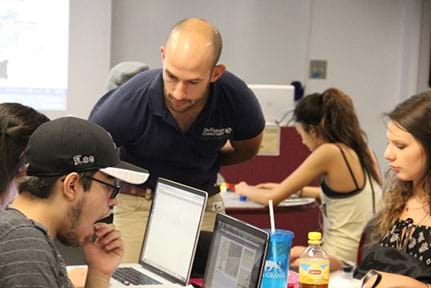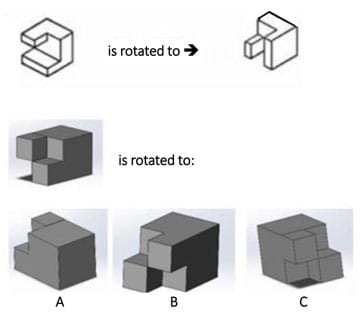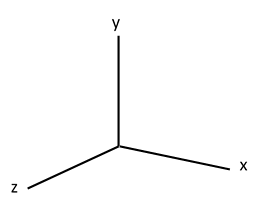Quick Look
Grade Level: 7 (7-9)
Time Required: 45 minutes
Expendable Cost/Group: US $1.20
Group Size: 2
Activity Dependency:
Subject Areas: Geometry, Problem Solving
Summary
Students learn about one-axis rotations, and specifically how to rotate objects both physically and mentally to understand the concept. They practice drawing one-axis rotations through a group exercise using cube blocks to create shapes and then drawing those shapes from various x-, y- and z-axis rotation perspectives on triangle-dot paper (isometric paper). They learn the right-hand rule to explore rotations of objects. A worksheet is provided. This activity is part of a multi-activity series towards improving spatial visualization skills.
Engineering Connection
Rotating objects is a technique used in spatial visualization and is part of understanding and effectively utilizing engineering software. Engineers use one-axis rotation drawings to better visualize 3-D objects to make sure their ideas represented on 2-D screens and paper work in the real (3-D) world in which the designs, products and inventions must function and operate. Spatial visualization is an essential skill for engineers to be able to take ideas to the next level; that is—ideas that initially only exist in the mind to something that can be communicated clearly to other engineers, and eventually turned into products, structures and systems.
Learning Objectives
After this activity, students should be able to:
- Rotate objects about one axis.
- Translate the rotation of one block to a second block.
- Use the right-hand rule to explore rotations of objects.
Educational Standards
Each TeachEngineering lesson or activity is correlated to one or more K-12 science,
technology, engineering or math (STEM) educational standards.
All 100,000+ K-12 STEM standards covered in TeachEngineering are collected, maintained and packaged by the Achievement Standards Network (ASN),
a project of D2L (www.achievementstandards.org).
In the ASN, standards are hierarchically structured: first by source; e.g., by state; within source by type; e.g., science or mathematics;
within type by subtype, then by grade, etc.
Each TeachEngineering lesson or activity is correlated to one or more K-12 science, technology, engineering or math (STEM) educational standards.
All 100,000+ K-12 STEM standards covered in TeachEngineering are collected, maintained and packaged by the Achievement Standards Network (ASN), a project of D2L (www.achievementstandards.org).
In the ASN, standards are hierarchically structured: first by source; e.g., by state; within source by type; e.g., science or mathematics; within type by subtype, then by grade, etc.
Common Core State Standards - Math
-
Draw, construct, and describe geometrical figures and describe the relationships between them.
(Grade
7)
More Details
Do you agree with this alignment?
-
Apply geometric concepts in modeling situations
(Grades
9 -
12)
More Details
Do you agree with this alignment?
-
Visualize relationships between two-dimensional and three-dimensional objects
(Grades
9 -
12)
More Details
Do you agree with this alignment?
State Standards
Colorado - Math
-
Modeling geometric figures and relationships leads to informal spatial reasoning and proof.
(Grade
7)
More Details
Do you agree with this alignment?
-
Objects in the real world can be modeled using geometric concepts.
(Grades
9 -
12)
More Details
Do you agree with this alignment?
-
Visualize relationships between two-dimensional and three-dimensional objects.
(Grades
9 -
12)
More Details
Do you agree with this alignment?
Materials List
Each group needs:
- 6 snap cubes (interlocking cubes); a set of 100 for $10-13 at https://www.amazon.com/Learning-Resources-LER4285-Mathlink-Cubes-100/dp/B000URL296 or https://www.amazon.com/Learning-Resources-LER7584-Snap-Cubes/dp/B000G3LR9Y
- pencil with eraser, for each student
- Blank Triangle-Dot Paper; two per student
- Let’s Rotate Worksheet, one per student
To share with the entire class:
- (optional) computer and projector to show examples as provided in the Spatial Visualization Presentation, a PowerPoint® file; alternatively, draw the examples for students
Worksheets and Attachments
Visit [www.teachengineering.org/activities/view/cub_spatviz_lesson01_activity3] to print or download.Pre-Req Knowledge
Before taking part in this spatial visualization activity, students should have taken the Spatial Visualization Practice Quiz and learned about spatial visualization in the associated lesson, Let’s Learn about Spatial Viz! They should know about isometric drawing, how to use triangle-dot paper and coded plans (as can be learned in the associated activity, Connect the Dots: Isometric Drawing and Coded Plans), as well as orthographic views (as can be learned in the associated activity, Seeing All Sides: Orthographic Views).Students should be familiar with the Cartesian coordinate system (x-, y-, z-axes) and degrees of rotation.
Introduction/Motivation
(Have the slide presentation up and displayed to the class, starting with slide 21.) Today we are going to learn about rotations! Rotating objects is an essential skill in the engineering world and it’s something we most likely already do every day. We use object rotation to understand the world around us—what objects are and how they fit together. For example, how do you know which direction to put a key in a lock? How do you organize your locker so that you can fit in more books? These tasks require the ability to visualize the one-dimensional rotations of objects.
In this activity, we are going to rotate both isometric drawings and blocks—very similarly to what you did on the Spatial Visualization Practice Quiz at the beginning of the associated lesson. Objects can be rotated about the three axes—x, y and z—and any combination of the three. We’ll start out rotating about one-axis.

(Show students slide 22, which is the same as Figure 1.) Take a look at the top row of this slide. Do you see that the first block on the left is the same block as on the right? We are simply looking at it from another angle. Now try to picture in your mind how the block rotates. What are some strategies you used to decide how it rotates? (Do not reveal the answer yet.)
(Show students slide 23, which is the same as Figure 2.) This is how we will define our axes: x and y on the horizontal and vertical axes, and z coming out from the page. The axes shown are the positive axes.
Looking back at the previous slide (slide 22), what axis is this object rotated about? (Answer: Z) And how many degrees is it rotated? (Answer: 90 degrees.)

Now we need to define the difference between a positive and a negative rotation with the right-hand rule (show slide 24). The right-hand rule is often used in physics and math to calculate vectors and rotations of objects. The right-hand rule works as follows: point your thumb parallel to the axis you are rotating about and curve your fingers naturally towards the palm of your hand. Your fingers will move in the same way the object will move. The axes shown in the previous slide (slide 23) are the positive axes, and if you flip the axis 180 degrees, you get the negative axes.
Everyone: Give your neighbor a thumbs up! Notice that your thumb is along the positive y-axis and your other fingers are rotating counter-clockwise. Now let’s try a thumbs-down. Notice that your thumb is now along the negative y-axis and your fingers are rotating clockwise.
Let’s look back at our example (slide 22). When we point our right thumbs along the z-axis to rotate this object, we can point towards ourselves (you can remember this by thinking “towards the zippers on our clothes”) or away from us. To rotate this block, which way would we point our thumbs? (Answer: Towards us.) So, this is a positive rotation.
Procedure
Before the Activity
- Gather materials and make copies of the Blank Triangle-Dot Paper and Let’s Rotate Worksheet.
- Prepare to project the Spatial Visualization Presentation, a PowerPoint® file, and use its content to aid in your instruction, as makes sense for your class. Slides 21-25 support this activity. The slides are animated so a mouse or keyboard click brings up the next image, text or slide.
With the Students
- Present to the class the Introduction/Motivation content. Also ask the pre-assessment question, as described in the Assessment section.
- Begin by handing out to each student two pieces of triangle dot paper and six cubes.
- Instruct students to do the following:
- Use the cubes to create a three-block-long rectangle.
- Draw the x, y and z-axes on the isometric paper.
- Rotate the object about the x-axis and draw the shape after rotation.
- Compare answers. (Expect all students to produce the same drawing.)
- As makes sense, show students the drawing tips on slide 25.
- Divide the class into groups of two students each. Explain that they will use two methods to draw cube shapes.
- Method 1: Block-n-Swap Relay
- Have students sit with their partners.
- Have each student use the cubes to build an object and then proceed to define a rotation by denoting one of the following: +x, +y, +z to indicate a positive 90-degree rotation about the x, y, or z axis.
- Have each student draw the original isometric view of the object and then draw the object after the defined rotation.
- After a few minutes, have students pass each object and defined rotation to their partners.
- Then the partners draw the rotated views of the objects.
- Have partners compare the isometric drawings with each other.
- Method 2: Peer Teaching with Coded Plans
- In pairs, one partner uses five blocks to build an object and then defines the coded plan with respect to a set of axes.
- Then each student draws the coded plans for a positive and a negative rotation about one axis.
- Then students explain to their peers how they drew the coded plans.
- Give students time to complete the exercises using the two methods.
- Assign students to complete the worksheet. Observe and assist as necessary.
Vocabulary/Definitions
orthographic views: A way to draw an object that shows three views of an object from the three planes in an orthogonal (right angle) coordinate system. The views represent the exact shape of an object as seen from one side at a time as you are looking perpendicularly to it. Depth is not shown. An orthographic drawing is also called a multiview drawing.
right-hand rule : A useful memory tool in the rotation of objects that uses a person’s right hand and fingers to help in understanding orientation conventions for vectors in three dimensions. Often used in physics and math.
spatial visualization: The ability to mentally manipulate two- and three-dimensional objects. It is typically measured with cognitive tests and is a predictor of success in STEM fields. Also referred to as visual-spatial ability.
triangle-dot paper: A grid of dots arranged equidistant from one another. Used in making isometric sketches. Also called isometric paper.
Assessment
Pre-Activity Assessment
Question/Answer: Ask students: Why are one-axis rotations important to engineers? Why would biomedical engineers designing a new heart valve need to see it from different views? Why is it important to see these different views? (Point to make: Our 3-D world is difficult to represent on 2-D screens and paper. The ability to rotate an object around in one’s mind helps complex, real-life challenges be understood more clearly. It is important for engineers to be able to visualize 3-D objects in order to make design decisions that will work effectively in the 3-D world in which our designs, products and inventions must function.)
Activity Embedded Assessment
Block-n-Swap: During the Block-n-Swap Relay, observe students to make sure they are able to draw the rotated objects. If they are struggling, assist them as necessary.
Worksheet: After students work through the two methods to draw cube shapes described in the Procedure section, assign students to complete the Let’s Rotate Worksheet. Observe whether students are able to draw the rotated objects or if they are struggling. Assist them as necessary. Review their answers to gauge their depth of understanding.
Post-Activity Assessment
Discussion: Ask students to explain and describe their drawings with specific focus on one-axis rotational views. What strategies did they use to draw their cube shapes? What were the limitations they experienced, if any? How did students solve any drawing challenges? Since everyone has worked through the same exercises, group sharing of their challenges and approaches informs the teacher of students’ depth of understanding and provides their peers with relevant ideas and tips.
Activity Scaling
- For lower grades, provide students with a longer time on the Block-n-Swap Relay. Also, spend more time introducing the concept by having the entire class make the same object, define a rotation and draw the rotation isometrically. Then, go over the correct answer with students. This provides less-advanced students with more time to fully practice and grasp the topic before branching off in pairs.
- For higher grades, have students use more blocks to make more complicated objects and during the Block-n-Swap Relay, and challenge them to rotate the objects (in their minds and drawings) without using the blocks to visually aid them. Adjust the time allotment as needed.
Subscribe
Get the inside scoop on all things TeachEngineering such as new site features, curriculum updates, video releases, and more by signing up for our newsletter!More Curriculum Like This

Students learn about two-axis rotations, and specifically how to rotate objects both physically and mentally about two axes. Students practice drawing two-axis rotations through an exercise using simple cube blocks to create shapes, and then drawing on triangle-dot paper the shapes from various x-, ...

In this lesson, students are introduced to the concept of spatial visualization and measure their spatial visualization skills by taking the provided 12-question quiz. Following the lesson, students complete the four associated spatial visualization activities and then re-take the quiz to see how mu...

Students learn about isometric drawings and practice sketching on triangle-dot paper the shapes they make using multiple simple cubes. They also learn how to use coded plans to envision objects and draw them on triangle-dot paper.

Students learn the concept of angular momentum and its correlation to mass, velocity and radius. In an associated literacy activity, students use basic methods of comparative mythology to consider why spinning and weaving are common motifs in creation myths and folktales.
Copyright
© 2011 by Regents of the University of ColoradoContributors
Emily C. Gill; Jacob Segil; Emily BreidtSupporting Program
Engineering Plus Degree Program, University of Colorado BoulderAcknowledgements
This activity was developed by the Engineering Plus degree program in the College of Engineering and Applied Science at the University of Colorado Boulder.
This lesson plan and its associated activities were derived from a summer workshop taught by Jacob Segil for undergraduate engineers at the University of Colorado Boulder. The activities have been adapted to suit the skill level of middle school students, with suggestions on how to adapt activities to elementary or, in some instances, high school level.
Last modified: April 13, 2021









User Comments & Tips